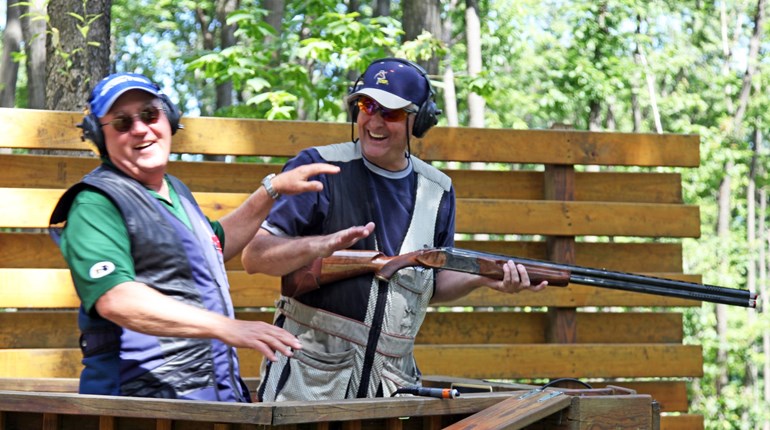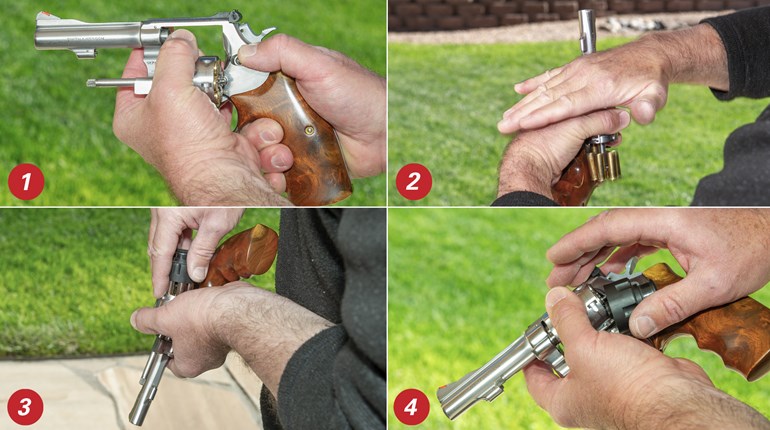
The range at which hunters sight-in their handgun is usually dictated by the type of hunting they plan on doing. Consider black bear or whitetail hunting: To make that shot count, knowing the range and bullet drop is critical (which is why I usually tape ballistic data to my scope). As an example of what range to zero-in that handgun, if hunting from a stand in the woods, I sight-in for a 50-yard zero. This covers shots I may be presented out there to around 100 or so yards. Also, what handgun/cartridge I am using is a critical factor. For another example, if using a single shot chambered for a rifle cartridge or a revolver, either single or double action with their blunt-nose bullets, that alone dictates how long a shot I may take. When contemplating what to use, the following data helps me to select what handgun/cartridge would be best for the type of hunting I will do. Consider these two options; a revolver in .44 Magnum or a single shot in .308 Winchester as per 50 and 100 yard zeros. For the revolver, the .44 Magnum with a 265-grain FP bullet and MV of 1,350 f.p.s. will generate around 1,072 ft.-lbs. of energy. At 50 yards, that drops to 877 ft-lbs. which is the range where I would zero in the revolver. Now take it to 100 yards, that bullet will drop around 4.3 inches and with less energy.
For the .308 Winchester, with a 180-grain SP bullet and MV around 2,000 f.p.s., that generates 1,600 ft.-lbs. of energy. At 50 yards, that drops to 1,460 ft-lbs. and at 100 yards, that bullets energy drops to 1,331 ft-lbs. which is the range I would zero-in this handgun/cartridge. Then at 150 yards, I still have 1,212 ft-lbs. of energy with the bullet dropping around 3.1 inches. As demonstrated, since not all cartridges generate the same stats, what you select should be used within its effective range as to energy and bullet drop.
Here are some thoughts on equipment, once you select the type of handgun and cartridge for the way you plan on hunting.
If you also carry a back-up, then consider open sights: For a back-up revolver to any firearm, especially if hunting dangerous game as boar or bear, open sights in my opinion is the best way to go. Such a handgun works well up close and on a moving target. To test this for yourself, try this (with a safe backdrop, of course!): Roll one of those white 5-gallon buckets with some soil in it and the lid secured down a hill as you shoot at it with a handgun equipped with various types of sights. When I did this with open sights, I consistently hit it. With a red dot sight, hits were also pretty regular. Then with a scope on 1 power, I hit a few but on 4 power, a blowout. I had trouble getting on target fast enough due to the magnification. This demonstrated that open sights are better on a back-up gun if you're so inclined to carry one, and that depends on what you are hunting and where.
Scope mounting and how to correct common problems you may encounter: Some scopes run out of adjustment. The best way to correct for this is with special rings. Just be careful that with rings that allow for extreme windage corrections, those adjustments can bend a scope tube. Careful!
Handguns can recoil a lot, which creates a negative effect on a scope. What usually happens is that they can move in the rings, which affects the zero. Using 3-4 rings on such handguns can stop this movement. I also find that Burris Signature Rings with their Posi-Align synthetic inserts secures the scope well. Then by using various sizes of inserts, you can keep your scope's internal optics centered.
Boresighting a Handgun: After mounting a scope, there are various ways to assure that you are at least on paper for that first shot of the sighting-in ritual. To tap into technology, I use a Boresighter from Simmons which came with various caliber arbors that attach to the optical unit while the stud is inserted into the barrel. Then I simply adjust the scope's crosshair center to the center of the unit’s grid. This simple procedure will get you on the target.
To eliminate arbors, I also have a unit from Leupold, their ScopeSmith Magnetic Boresighter that attaches to the muzzle, thus eliminating the need for arbors. Now adjust your scope to the grid!
Laser Options: These are also accurate with units available that attach to the muzzle as per magnets or are inserted into the barrel.
The Laser Boresighter: I also use the Wheeler unit that emits a green laser dot. To use, attach it to the muzzle as per its magnetic connection, point at a target and adjust your scopes' center to that dot.
Tips on Practicing: Once we set up our handgun with whatever sighting system, we should then go to the range and shoot from a solid bench so to check the gun and not our skills. Then once we select at what distance we anticipate a shot and therefore set the sight to that range, we are ready for practical practicing, which has a lot to do with target selection.
Circular Target: When sighting-in your handgun, you need a standard target to group your shots. The key is in having an aiming point, which is necessary when shooting for consistency. Now when sighted-in, put out a tin can and due to the small target, your eye focuses on it and nothing else which helps you to center aim your shot and hit the can.
Game Size Targets: To add a challenge to practice, put at 50 yards a target or drawing of the animal you plan to hunt. At first, what you may experience is that with the circle gone, there is some hesitation on where to aim. This is why it is also a good idea to constantly look at a photo of the animal’s anatomy. Now when you look at an illustration of the animal or the live animal in the woods, you can see in your mind the vitals and immediately know where to aim.
As stated, there are many options available and they all work! Bushnell even has a laser boresighter that uses expandable caliber adaptors. As a suggestion, get started months before you intend to actually hunt and good luck.







































